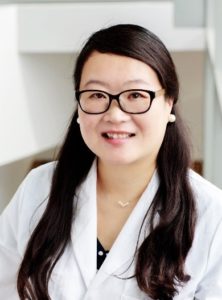 Dr. He is a tenure-track assistant professor at the University of Kansas. She received her PhD degree from the University of Alberta with professor Jed Harrison, and postdoctoral training from the University of California, Berkeley with professor Amy Herr. She is the vice chair of the ASABE Biosensor program and the Councilor of the American Electrophoresis Society. Dr. He is also the founder of Clara Biotech Inc. and the founder committee for the MidWest 3D technology society. Dr. He Received NIH Maximizing Investgator’s Research Award for Early Stage Investigators in 2019. She also received the Lab on Chip Outstanding Reviewer for the year of 2018. One of her publications also received the 2018 SLAS Technology Readers Choice Award. Her research interests include biomedical microfluidic devices and sensing approaches, 3D biomaterials, and nanodelivery, employed in programming and monitoring biomimetic immunity associated with extracellular vesicles.
Dr. He is a tenure-track assistant professor at the University of Kansas. She received her PhD degree from the University of Alberta with professor Jed Harrison, and postdoctoral training from the University of California, Berkeley with professor Amy Herr. She is the vice chair of the ASABE Biosensor program and the Councilor of the American Electrophoresis Society. Dr. He is also the founder of Clara Biotech Inc. and the founder committee for the MidWest 3D technology society. Dr. He Received NIH Maximizing Investgator’s Research Award for Early Stage Investigators in 2019. She also received the Lab on Chip Outstanding Reviewer for the year of 2018. One of her publications also received the 2018 SLAS Technology Readers Choice Award. Her research interests include biomedical microfluidic devices and sensing approaches, 3D biomaterials, and nanodelivery, employed in programming and monitoring biomimetic immunity associated with extracellular vesicles.
Read Mei He’s Emerging Investigator article “3D-printing enabled micro-assembly of a microfluidic electroporation system for 3D tissue engineering” and find out more about her in the interview below:
Your recent Emerging Investigator Series paper focuses on “3D-printing Enabled Micro-assembly of Microfluidic Electroporation System for 3D Tissue Engineering”. How has your research evolved from your first article to this most recent article?
My first article observed the microscale evolution of porous polymer materials in the microfluidic channel when I was a PhD student. I found very interesting phenomena in the microfluidic device which actually inspired me to explore more surrounding dimensions, surface chemistry, and scales. Till to my recent article focusing on 3D geometric influence on cellular behavior and their extracellular vesicles secretion dynamics, the 3D dimension in microscale is intriguing in the biological system.
What aspect of your work are you most excited about at the moment?
I am very excited to take the microfluidic technology and phenomena into the biology world, as it will bring new investigation and discovery. Biology is still in its infancy stage, I am very excited to see how microfluidic technology could advance this growth.
In your opinion, what is the biggest impact your microfluidic electroporation system will have in tissue engineering?
Intracellular delivery of regulatory or therapeutic targets into the cell is very crucial in the field of tissue engineering and regenerative medicine. Current existing electro-transfection systems, including microfluidic platforms and commercial benchtop systems, are only able to study monolayer cell suspensions in vitro, which is incapable of clinical translation within in vivo tissue microenvironment. So developing a 3D, in vivo like tissue microenvironment with effective electro-transfection is very important to move to the clinical study in the future. We actually are more interested in downstream, precise control and manipulation of cellular machinery for secreting exosomes and extracellular vesicles under the transfection-induced stimulus, such technology is not existing yet but very important for understanding the interconnection of cargo internalization with cellular level responses elicited by exosomes delivery pathway.
What do you find most challenging about your research?
Building up an in vivo like tissue system with precise control is not straightforward. The environment in a controlled lab setting is totally different than in an in vivo biological system. So the analyzed information actually is not representative of the real situation in the human in vivo system. There are huge heterogeneities present in the cell population as well as human individuals, which poses the challenges for correctly understanding cellular system regulation, such as immunity, in our human body. Mimicking in vivo living system is very challenging, but crucial for understanding quite a few of mechanism and disease pathogenesis. Our research introduces new microfluidic technology and material solutions to solve such challenges.
In which upcoming conferences or events may our readers meet you?
I will attend next year Gorden Research Conference in Bioanalytical Sensors as well as the MicroTAS annual meeting.
How do you spend your spare time?
I have a 7-year-old boy and expecting a new baby girl this year. My spare time definitely is occupied by kids and watching them growing.
Which profession would you choose if you were not a scientist?
I always like to discover new things since I was a child. If I am not a scientist, I would like to be a greeting card designer or paleontologist.
Can you share one piece of career-related advice or wisdom with other early career scientists?
Being a life-long learner and always keeping strong scientific curiosity will definitely help with your research development. Get good mentors around you and you will appreciate their advice.










